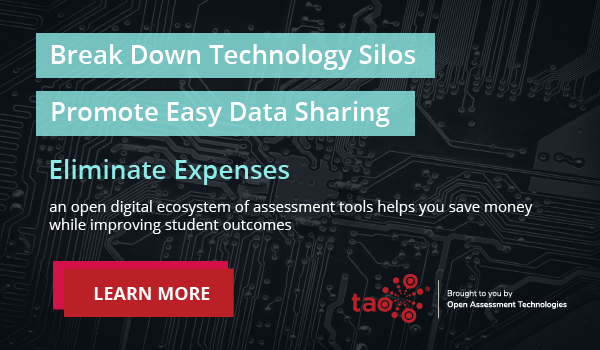While many educators are aware of computer adaptive testing (CAT) and the benefits it offers for students, it can be difficult to step away from the familiarity of traditional assessment methods. Teachers may be unsure of how to design and implement an adaptive test and might even question whether CAT is right for their students.
While that’s understandable, the benefits of CAT for teachers and students should outweigh any doubts. Adaptive testing allows for personalized assessment that can deliver accurate measures of student performance, capturing the outliers as well as the mean—all while saving educators time.
In this article, we’ll look at proven strategies for implementing adaptive assessments: item adaptive testing, testlet adaptive testing, and branching (multistage adaptive) assessments. By applying these best practices, educators can design scalable assessments that meet the needs of every learner.
Key Takeaways
- Adaptive tests tailor questions to individual student abilities, providing a more accurate and customized evaluation of student performance.
- You can use a variety of question difficulties in each testlet to effectively challenge both high-performing and struggling students.
- Computer adaptive testing allows you to monitor item, student, and group-level data to get insight into progress and common needs.
- The data from adaptive testing can inform decisions about interventions, curriculum, and teacher training.
What Are Testlet, Item, and Branching Adaptive Tests?
Testlet adaptive, item adaptive, and branching assessments are all types of CAT, which adjust successive question items on the basis of students’ past answers. One of the key benefits of adaptive testing is the ability to reduce test length without decreasing the accuracy of the assessment. Since the test adapts to each student’s ability, fewer questions are needed to determine their proficiency compared to traditional testing methods.
Testlet adaptive assessments consist of groups of questions (testlets) that adapt to a test-taker’s performance at the level of the entire group rather than individual questions. After students complete each question group, the computer presents them with a new testlet that matches their level of knowledge. When compared to a traditional linear test structure, adaptive testlets allow for greater flexibility in test design, where sets of questions can differ according to skill area, difficulty, or subject matter.
On the other hand, item adaptive assessments adapt after each individual question is answered, so they often require students answer even fewer questions to capture insight into their proficiency. This approach also offers granular control, making the assessment highly personalized to the test-taker’s current ability level. Check out our article, Adaptive Assessment: What Possibilities Do You Have? to learn more.
Branching assessments, also referred to as multistage adaptive, dynamically adapt to a student’s performance by presenting questions based on predefined pathways determined by their answers to previous questions. For example, a test might start with a foundational, fact-based question. Based on the student’s response, the assessment could progress to more advanced questions that demand higher-order thinking and a deeper grasp of the subject matter.
These adaptive CAT approaches aim to optimize the assessment process, offering flexible, efficient, and personalized testing that leads to greater accuracy and more reliable results.
How To Use Computer Adaptive Testing
1. Align assessment content with learning objectives
To scale adaptive testing across a school district, assessments must be aligned with learning goals. This way, test outcomes can be used both as a marker of student achievement and a way to evaluate institutional performance.
Moreover, if a school system follows particular standards, such as the Common Core State Standards (CCSSs), for example, then digital literacy requirements are attached to each content area. Platforms like TAO are built with education standards in mind so that teachers can verify that their courses meet these standards. TAO’s range of technology-enhanced items (TEIs) is ideal for assessing a student’s ability to make strategic use of digital media while demonstrating their understanding of key subject concepts.
Best Practice: Start by clearly defining the competencies and learning objectives for your course or subject. Design each testlet or item to target a particular skill, and consider using curriculum mapping tools to comprehensively cover standards.
2. Ensure a wide range of difficulty
One of the main benefits of computer adaptive testing is that it can offer insight into student performance at the extremes as well as around the mean. To do so, however, adaptive test item banks have to contain a broad range of question difficulty. That way, a test can challenge advanced learners while providing appropriately leveled questions for those who may struggle.
Keep in mind: It can take more time to design an adaptive test, because the test item bank needs to be larger than in a traditional test. That additional work will pay off in the form of better insight into student needs—and in the time saved through automated grading.
Best Practice: Develop testlets with a range of easy, moderate, and difficult questions. Within each set, questions should progress in difficulty, offering opportunities for lower-ability students to demonstrate foundational knowledge and higher-ability students to showcase mastery.
For example, in a math test, the first testlet might focus on basic algebra, while subsequent testlets could increase in complexity, testing quadratic equations or advanced calculus based on the student’s performance. This ensures that testlets assess higher- and lower-order thinking along the same scale.
3. Use data to refine adaptive testing logic
Adaptive testing relies on logic (either algorithmic or pre-defined branching rules) to determine which testlet or question to present next. The accuracy and effectiveness of these algorithms depend on high-quality data about student performance.
Best Practice: Regularly review the data produced by your testing system to refine the logic over time. This can include analyzing how often students are routed to different difficulty levels, whether test questions are balanced in terms of challenge, and if the adaptive pathways are correctly identifying areas where students need more support.
4. Track progress over time
Using a platform like TAO, educators can track student progress more precisely than with traditional assessments. In addition to getting more insight into performance with each test, TAO’s analytics give teachers and administrators a comprehensive view of student progress over the course of a learning period or school year. And, should they choose to share reports with parents, these analytics can be a springboard for more family engagement and feedback.
Best Practice: Implement a system that allows for longitudinal tracking of student data. This can include measuring performance on specific learning objectives over time, comparing initial assessments to later ones, and tracking the progression of difficulty levels reached by each student.
For instance, if a student initially struggles with foundational questions but later demonstrates proficiency in more complex topics through adaptive testing, this indicates clear improvement. Such data can be invaluable for educators seeking to identify successful teaching strategies or interventions.
5. Provide immediate, personalized feedback
When setting up an assessment in TAO, educators can configure the test to provide instant feedback with scoring so students can immediately see how well they did.
Because they include this automated grading, computer tests give teachers time to prepare and share more detailed feedback that is specific to each student’s performance. Timely feedback can significantly enhance students’ learning experiences by identifying strengths and areas for improvement while the material is still fresh.
Best Practice: After each test part or assessment, provide the student with detailed information on their performance, including what they did well, where they struggled, and what they can do to improve. Personalize the feedback by connecting it to their performance on previous assessments to show their growth or ongoing challenges.
For instance, if a student consistently struggles with a particular concept, the system can recommend additional resources or suggest extra practice on that topic, supporting a more targeted approach to remediation.
6. Monitor group-level data for instructional insights
While individual student data is crucial, it is also essential to analyze group-level data to determine how well students are meeting learning objectives across a class, grade level, or institution. EdTech platforms like TAO can make trend identification easier with visualization tools and custom dashboards.
This group-level data is critical for administrators to ensure that assessments are fair and beneficial to all students. Institutions can make quicker and better-informed decisions about interventions, resource allocation, and curriculum adjustments when they have comprehensive data.
Best Practice: Administrators should use aggregated data from adaptive tests to identify common areas of difficulty among students, and to provide educators with data-driven insights into how they can improve their instructional approach.
For example, if a large percentage of students are struggling with a particular concept, it may indicate a need to revisit that topic in class. Alternatively, it could mean that educators need to adjust the way they teach that concept or find supplemental materials to address it.
The Bottom Line
Computer adaptive testing offers a practical, efficient solution for personalized assessment in education. By aligning test content with learning objectives, ensuring a broad range of question difficulties, and regularly refining approaches using performance data, educators can create more accurate and tailored assessments.
Best practices like tracking student progress over time, providing immediate feedback, and analyzing group-level data can help identify learning gaps and further enhance instructional strategies. To learn more about using TAO to implement computer adaptive testing, check out these helpful resources:
- Choosing the Right Assessment Tools: A Guide for Schools
- 4 Common Challenges When Shifting to Digital Assessments—and How to Overcome Them
- Measuring Learning Success: 3 Tools and Strategies for Educators
Adaptive Testing FAQs:
- How do branching and adaptive tests differ from traditional tests?
While traditional tests present the same set of questions to every student, branching and adaptive tests adjust the difficulty of questions based on a student’s performance in real time.
- Can adaptive tests be used for all subjects?
Yes, adaptive tests can be applied across various subjects, from math to language arts, as long as the content is structured to allow for progressive difficulty.
- How do adaptive tests improve student outcomes?
By personalizing assessments to each student’s ability, adaptive tests identify specific strengths and weaknesses, allowing educators to provide faster, tailored feedback and relevant teaching interventions.


